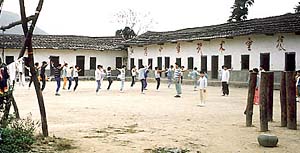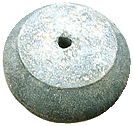



















 Members of CCB's Computer Section discuss advancement in technology which has led to the complex nature of computer crime |
DUE to the advancement of technology and the complex nature of computer crime, the Computer Crime Section (CCS) under the Commercial Crime Bureau (CCB) was established in 1993 to combat its rise. The section, led by a chief inspector, is comprised of three teams whose prime duty is to investigate offences created under the Computer Crime ordinance. Each team is headed by an inspectorate officer who is assisted by a sergeant and constables. The section is also responsible for the examination of computer-based evidence which provides key exhibits in criminal investigations to prove guilt of an offence. At present, the section's customers include various Force units as well as other Government departments. |
|
Said Acting Superintendent Kevin Li Chiu-yin of Division A of CCB: "The section has effectively applied the existing laws of Hong Kong to prosecute such computer-related crimes as hacking, criminal damage to a computer system and, increasingly, criminal activities committed through the Internet." In the past four years, the CCS has dealt with a number of hacking cases and successfully prosecuted two. "These relatively low figures belie the high instances of the crime," explains Ag SP Li. "Skilful computer criminals hack into computer systems, then read and steal confidential information on it. If they do not damage the system, legitimate operators may never realise the system has been violated. Or if they do, they frequently put it down to a system malfunction, in which case the crime is never reported." The upsurge in computer crime has led to the need for a central Force advisory unit - which the Computer Crime Section has assumed, giving consultative assistance to all police units in the handling of computer-related crime and computer-based evidence. "We are happy to provide advice and technical support to colleagues when they seek it, as many officers are understandably unclear on what laws are applicable to certain Internet offences," said Ag SP Li. "For example, the publication of obscene articles via the Internet and on-line computer shopping fraud, have been defined as cases of vice and deception respectively. Further, before any legal action can be taken in Hong Kong over a case involving the publication of obscene articles on the Internet, we have to prove that the articles were released from a Hong Kong web page." The Computer Crime Section has recently produced a booklet entitled "Action at the Scene of the Crime Involving a Computer", with similar publications to follow on other areas of computer-related crime and evidence collection. "Another instance of a computer crime on the increase occurs when disgruntled employees take revenge by purposely erasing valuable information on a company's or an institution's computer system," said Detective Senior Inspector Collins Leung Tak-kwong, who has worked in the section for three years. "Often in such cases, circumstantial and technical evidence within the computer system itself is the key to finding the culprit." The number of cases involving people compromising passwords used by commercial companies to activate their Private Automatic Branch exchange (PABX) telephone system and illegally use the IDD function to make free long distance calls is also on the rise. Said Detective Senior Inspector Leonard Ma Hok-hon: "To keep up with advances on the information highway and world-wide trends in computer crime, officers of the section must keep abreast of the latest technological developments, conduct extensive research to fine tune their investigative and computer examination skills, and regularly undergo training that includes courses organised by local and overseas institutions." The Computer Crime Section is now in the process of recruiting JPOs who are enthusiastic and excited about new and evolving computer technology and feel challenged by the idea of combating high-tech crime. Although preference will be given to those with previous exposure to computer technology and crime investigation, it is not essential. On the job training will be provided to successful candidates. A pre-recruitment seminar will be held for officers interested in the section's challenging work in March this year. For more details contact DSIP Leonard Ma: 2860-4801; or Sergeant Lee Kai-hung: 2860-2307. | |
|
A TOUR organised by the Police Chinese Wushu
Club will make a pilgrimage to the South Shaolin Monastery in Fujian Province in April to trace the roots
of Chinese martial arts while at the same time raising money to build schools in the western mountainous
regions of that province.
The North and South Shaolin Monasteries in Sungshan and Fujian are where the Chinese martial arts originated. |
 Fujian martial arts devotees practice in the Shaolin school nearby the ruins of the orginial monastery |
|
About 1500 years ago, the original North Shaolin Monastery in Sungshan dispatched 13 of its monks - who were masters in the martial art of stick fighting - to lead 500 monk warriors to help their Emperor put down a disturbance in the south. Not only was the uprising put down, but the monks stayed on to set up a South Shaolin Monastery in Fujian Province, thus bringing the ancient Shaolin martial arts to the southern parts of China. The emperor of the following Qing Dynasty, however, ordered the two monasteries destroyed because the Shaolin monks supported the ruler of the previous Dynasty. "The historical site of the South Shaolin Monastery was discovered only recently and to my knowledge this is the first time any Hong Kong martial arts organisation will tour the site," said SSP Choy Kin-cheung, DDC Sau Mau Ping District, the Chairman of the Police Chinese Martial Arts Club, who toured the area last year in order to prepare and co-ordinate the upcoming pilgrimage that takes place from April 10 to 16. "We see this trip as appealing to Chinese martial arts enthusiasts interested in tracing the roots of Wushu," he added. "We're hoping to attract about 50 people." The scope of the tour includes three treks which cover a four-hour walk from Xiamen City to inland Fujian; a two-hour excursion which crosses the Luoyang Bridge in Quanzhou City; and a gruelling climb from the bottom to the top of Nine Lotus Mountain where the ruins and huge artefacts of the monastery are situated. Pilgrims can also visit the Red Flower Pavilion near the site which is believed to be an important place of development of Triad societies. "In addition, we will be meeting and exchanging experiences with local area Wushu organisations," said SSP Choy. | |
 Ancient Shaolin dumb-bell |
The trip costs $4,500 per person, with each applicant also required to raise $30,000 - half of which goes to The Friends of Hope Education Fund, and the remainder going to help support the Club's school building projects in Fujian Province. Enquiries: SSP Choy Kin-cheung, 2797- 4201; or SSgt Shum, 2611-3305. |

